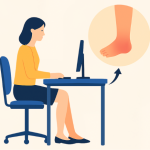Job rotation is much discussed across risk management, HR, and flexible working contexts. This is because the potential benefits of rotating jobs in a workplace are myriad, spanning ergonomics, employee satisfaction, and business productivity gains.
In this article, we explore all benefits of effective job rotation programs, address potential hurdles in setting up rotational jobs, and bust some common job rotation myths.
What is job rotation?
Job rotation is a workplace strategy where employees move between different roles, tasks, or departments at set intervals.
Unlike promotions, these moves are usually lateral, meaning the employee remains at the same level of seniority and pay but gains exposure to new responsibilities, skills, and perspectives.
Rotational jobs can take different forms. Some are temporary, with employees returning to their original position after a fixed period. Others follow a regular cycle, with staff rotating through multiple roles in a year. In both cases, the aim is to balance organizational needs with employee development and wellbeing.
Related: Find out why line managers are crucial to improving employee wellbeing.
Benefits of job rotation
Job rotation brings a wide range of benefits for both employees and organizations.
Rotational jobs reduce ergonomics risk by introducing variety
One of the most immediate advantages of job rotation is its impact on ergonomics. Repeatedly performing the same physical task, whether lifting, typing, or standing at a production line, increases the risk of musculoskeletal disorders (MSDs) and fatigue.
Related: Explore steps for controlling MSDs in the workplace.
By alternating tasks, job rotation introduces physical variety. For example, an employee who spends part of the day in a seated role and part of the day on their feet experiences less strain than if they remained in one posture all day. This approach:
- Spreads physical demands more evenly across the workforce.
- Helps prevent overuse injuries linked to repetitive movements.
- Supports long-term wellbeing by reducing cumulative strain.
For businesses, this means fewer absence days, lower healthcare costs, and a healthier, more productive team.
Job rotation limits exposure to high-risk tasks
In many industries, certain tasks carry a higher level of physical or mental strain. These might involve heavy lifting, exposure to noise or chemicals, or periods of intense concentration.
If one person is consistently assigned these duties, the likelihood of fatigue, injury, or error increases significantly.
Job rotation helps to share the load. By alternating responsibilities, no single worker is overexposed to hazardous or high-demand tasks. Instead, risk is distributed more evenly across a team. This approach:
- Reduces the chance of work-related injury or ill health.
- Helps maintain alertness and accuracy when carrying out safety-critical duties.
- Ensures compliance with health and safety standards by keeping exposure within safer limits.
Related: Beyond ergonomics compliance: Why the extra mile matters
This not only protects employees but also strengthens organizational resilience, keeping productivity steady even in demanding environments.
Rotating jobs may result in broader competencies across the workforce
Job rotation exposes employees to a wider variety of tasks, processes, and responsibilities than they would encounter in a static role. Over time, this helps individuals develop a broader skill set, increasing their versatility and value within the organisation.
Benefits include:
- Enhanced adaptability: Employees become comfortable working across multiple functions, making it easier to cover absences or respond to changing business needs.
- Skill development: Workers gain hands-on experience in different areas, from technical skills to problem-solving and decision-making.
- Knowledge sharing: As employees rotate, they bring insights and best practices from one role to another, helping break down silos and improve overall team performance.
Broadening competencies also supports long-term workforce planning. Organizations with multi-skilled employees can respond more flexibly to operational challenges.
Job rotation programs can inform better talent management and succession planning
Rotating employees through different roles provides managers with a clearer picture of individual strengths, weaknesses, and potential.
By observing employees in varied contexts, organisations can make more informed decisions about promotions, training needs, and future leadership opportunities.
Key advantages include:
- Identifying high-potential employees: Employees who adapt quickly and excel in multiple roles are often strong candidates for leadership or specialized positions.
- Targeted development: Job rotation highlights skill gaps, allowing employers to offer tailored training and mentorship to prepare staff for future responsibilities.
- Succession planning: By gaining insights into employee capabilities across roles, organizations can create robust succession plans, ensuring key positions are filled without disruption.
- Retention and engagement: Employees who see clear paths for growth and development are more likely to remain engaged and committed, reducing turnover and retaining institutional knowledge.
A well-structured job rotation program not only develops individual employees but also strengthens organizational resilience by building a versatile, experienced, and motivated workforce.
Rotating jobs can increase job satisfaction
Job rotation helps break up routine tasks and injects variety into employees’ daily work. This variety can reduce boredom, boost engagement, and improve overall job satisfaction.
New skills foster a sense of achievement and growth, while taking on new roles deepens an employee’s understanding of the organization, helping them to feel more connected to processes and outcomes.
Job rotation can also enhance workplace relationships as employees get the opportunity to work in different teams or departments, encouraging empathy, communication, and collaboration.
Overall, when employees feel more engaged and valued through meaningful job rotation, they are often more motivated, productive, and committed to the organization.
Potential barriers in implementing job rotation programs
While job rotation offers numerous benefits, organizations can encounter challenges when attempting to introduce rotational roles. Awareness of these barriers helps employers plan programs that are both effective and sustainable.
1. Job suitability and qualifications
Not all roles are appropriate for rotation. Some positions require specialized skills or certifications, meaning not every employee can perform them safely or effectively.
Job rotation may also be unsuitable in departments where tasks are highly technical, regulated, or critical to operations.
2. Resistance from employees
Although research shows that employees generally have a positive outlook on job rotation as it relates to themselves, productivity, job security, and the organization at large, some may be reluctant to participate in rotations due to:
- Preference for familiar tasks or “easier” jobs.
- Hesitation to learn new skills or responsibilities – particularly if they feel enhanced value to the organization through gained competencies should be reflected in their salary.
- Concern about giving up their current role to colleagues.
3. Supervisory and management challenges
Implementing rotation programs can be seen as resource-intensive. Supervisors may worry about:
- Short-term productivity losses and potential impacts on product quality.
- The administrative effort required to manage rotations and training schedules.
- Managing employee pushback or dissatisfaction.
- Convincing leadership that long-term benefits outweigh perceived short-term costs.
4. Organizational policies and regulations
Union agreements, workplace policies, or compensation structures may limit the feasibility of rotating certain roles. Compliance with these rules is essential to avoid disputes or legal complications.
5. Cultural and behavioural hurdles
Job rotation programs require a culture that values flexibility, learning, and collaboration. In organizations where employees and leaders are resistant to change, or where short-term targets dominate decision-making, rotations may be difficult to implement successfully.
Busting common myths about job rotation programs
- Myth #1: “Job rotation will fix ergonomic issues.”
Job rotation is a tool to reduce repetitive strain and exposure to risk, but it is not a substitute for comprehensive ergonomic programs. Workstations, tools, and workflows still need to be optimized to prevent injury and discomfort.
- Myth #2: “Quality and productivity will inevitably suffer.”
While short-term adjustments may be required, a well-planned rotation program can maintain or even improve quality and productivity. Employees trained in multiple roles gain a better understanding of processes, which can lead to more consistent outcomes.
Research has proven that, as long as employees are generally good performers to begin with, job rotation helps them reach even higher levels of performance.
- Myth #3: “Job rotation is difficult to manage.”
With clear schedules, role definitions and training, rotation is no harder to manage than standard assignments. In fact, multi-skilled employees offer managers greater flexibility when allocating work or covering absences.
- Myth #4: “Designing a rotation program is straightforward.”
Effective rotation design is one of the most critical and challenging aspects. Factors like muscle groups used, postures, repetition, force, tools, and skill requirements must be considered to ensure safety and efficiency. Poorly designed rotations can negate the benefits of the program.
- Myth #5: “Employees and management won’t accept it.”
Acceptance increases when the benefits are communicated clearly. Engaging employees, demonstrating safety improvements, and securing top-level commitment are key to overcoming resistance. Most employees and managers respond positively once the advantages of rotation are understood.
- Myth #6: “Job rotation is only for large organisations.”
Even small businesses can implement rotation on a smaller scale. The principle — reducing monotony, spreading skills, and mitigating risk — is valuable in organisations of any size.
- Myth #7: “Job rotation replaces training and development programs.”
Rotation complements training initiatives, but it does not replace formal education or skill development. Employees still require structured learning to safely and effectively perform their roles.
Manage ergonomics risk with Cardinus
Job rotation can be an effective tool to reduce exposure to repetitive tasks and high-risk activities, but it is not a complete solution for workplace ergonomics. While we recommend implementing rotation where possible, it should only form one part of a broader risk management strategy.
For a comprehensive approach, Healthy Working, our office ergonomics management software, provides end-to-end support, helping you assess, monitor, and control ergonomic risks across all workstations.
Get a free trial of Healthy Working, and start managing ergonomics risk effectively today.
Healthy Working Pro, on the other hand, is designed specifically for managing ergonomics risk in non-office and industrial work environments. Find out more.





